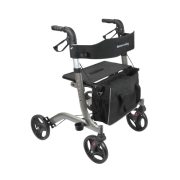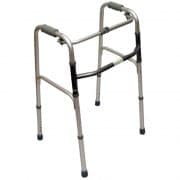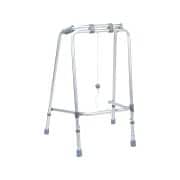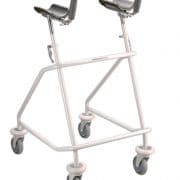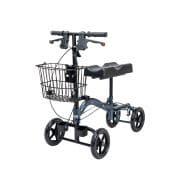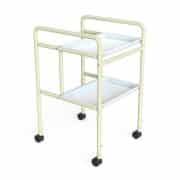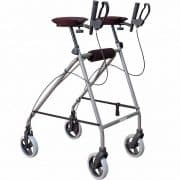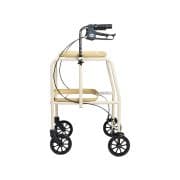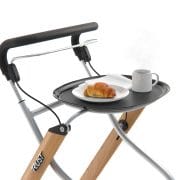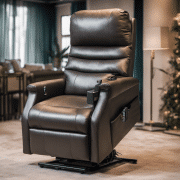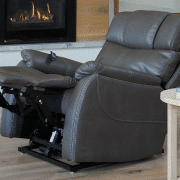How To Use A Walking Frame Correctly and Safely
Meet the walking frame, your personal mobility superhero, also known as a walker or Zimmer frame. Walking frames can be a game-changer when it comes to getting back on your feet. It’s like having a loyal ally by your side, designed to lend a helping hand (or four) to keep you moving when balance and...

Meet the walking frame, your personal mobility superhero, also known as a walker or Zimmer frame. Walking frames can be a game-changer when it comes to getting back on your feet. It’s like having a loyal ally by your side, designed to lend a helping hand (or four) to keep you moving when balance and stability are in short supply.
Whether it’s age-related frailty, a pesky injury, surgery, or those challenging medical conditions, your walking frame has got your back, quite literally! But remember, to unlock its superpowers and ensure safety and independence, you’ve got to master the art of using it correctly to ensure your safety and comfort. Join us on this comprehensive journey as we explore the ins and outs of walking frame mastery.

You might also be interested in Understanding Mobility Aids: Types, Uses and Benefits; How to use a Walk Belt; How to Choose a Walker; The Ultimate Home for People With Reduced Mobility; Best Toilet Aids for the Elderly to Make it Easier and Safer.
Unleash Your Inner Mobility Hero: Who Should Use a Walking Frame?
Let’s start at the beginning. Who are these nifty mobility aids for? Well, walking frames are trusty sidekicks for individuals who:
- Have difficulty maintaining balance while walking.
- Need support for their upper body due to weakness or mobility limitations.
- Are continuing on the path to recovery after surgery or injury through rehabilitation.
- Experience pain or fatigue while walking.
- Struggle with neurological conditions, such as Parkinson’s disease or multiple sclerosis.
Now that you know if you’re in the walker-wielding league, let’s dive into the benefits and art of choosing the ideal walking frame.
Benefits of Using a Walking Frame Correctly
Mastering the art of walking with a walking frame comes with numerous benefits:
- Enhanced Mobility: You can move confidently and independently.
- Improved Safety: Reduced risk of falls and injuries.
- Increased Independence: Maintain your freedom to explore.
- Reduced Fatigue: Walking with proper support is less tiring.
- Better Quality of Life: Enjoy everyday indoor and outdoor activities with ease.
Now, let’s continue this adventure and uncover more secrets to walking frame mastery!
Choosing the Right Walking Frame:
Walking frames come in various types, from standard models with rubber stoppers to wheeled walking frames designed with castor wheels and glides, and specialty frames that offer even more support. Picking the right one is like selecting the perfect superhero outfit—it needs to suit your unique needs. Here are some factors to consider:
- Height and Weight: Ensure your chosen frame can bear your body weight and that the handles are at a comfortable height. Adjust the walking frame while wearing your everyday shoes; remember to stand upright in a relaxed position with your hands by your sides for a precise height-setting.
- Handle and Armrest Tweaks: Personalise your frame by adjusting the handles and armrests in the correct position for optimal comfort. Make sure the handles are at hip level (wrist crease height) for a smooth, confident stride when using two wheeled or four wheeled walkers. If you are using a walker with specialised forearm gutters, stand in a comfortable upright position. The gutters should be forearm level with your elbows slightly bent. Slide your forearms into the gutters and grip the walker’s handles.
- Frame Positioning: Keep your frame close to maximise its support potential as a walking aid. Remember, it’s meant to be your reliable companion, not a distant acquaintance.
- Terrain Consideration: Think about where you’ll flaunt your frame—indoors, outdoors, or a mix of both? Most frames are born for indoor strolls and keeping on the path well traveled when outdoors.
Now that you’ve unlocked the secrets to choosing the perfect sidekick, it’s time to embark on your adventure with your trusty walker by your side.
Using the Walking Frame: Strut Your Stuff
Whether you have the standard frame with four rubber stoppers or the wheeled wonder, using it correctly can unlock its full potential. Let’s get to the nitty-gritty of using your walking frame:
- Standard frame with four rubber stoppers, also known as ferrules: The trusty sidekick designed for those short-distance adventures when you need a little extra support. To use it effectively, lift the frame slightly forward, ensuring all four tips are firmly on the ground. Take a step with one leg, transferring your body weight through the frame, and then bring the other leg alongside. Be mindful not to step too far ahead to maintain balance. Safe use of this walker requires sufficient strength and balance.
- Walker equipped with wheels and glides: These walkers are the go-to for those who can stand with a smidge of support but crave some extra help on their walks, especially indoors and over shorter distances. Stand tall, gripping the frame with both hands like a pro. Now, gently slide the frame forward, step with one leg while transferring your weight through the frame, and then bring the other leg past the first.
- Stepping in and out: Practice safe techniques for stepping into and out of the frame. The recommended technique involves initiating the step with your weaker leg to distribute weight away from it and depend on the walker for balance, followed by advancing with your stronger leg.
- Posture and alignment: Stand tall in a comfortable position, distribute your weight evenly, and keep your elbows slightly bent and relaxed. Remember, it’s a walker, not a crutch.
- Taking the first steps: Small, controlled steps are your best friends. Move the frame forward with each step, and don’t rush. When turning corners, it is important not to spin directly on the spot, but to walk in a wider turning circle. Be the tortoise, not the hare.
- Obstacles and stairs: Tread carefully around obstacles, and under no circumstances should you try to climb stairs without a proper handrail or banister. Approach an occupational therapist to show you the proper technique for conquering the stairs. Safety first!
With these techniques in your utility belt, you’re ready to embrace the world with confidence!
Tips for Walking with a Walking Frame:
Whilst your walking frame is your trusty sidekick, you will inevitably encounter various terrains and villainous obstacles on your journey.
- Different Terrains: Be cautious when walking on uneven surfaces or gravel. Consider using a Rollator with larger, all-terrain wheels instead of a walker for those daring adventures.
- Navigating Stairs: If you don’t have a Stair Climber Walker or aren’t familiar with the correct technique, using stairs is not recommended. Look into alternatives like stairlifts or specialised stair-climbing aids.
- Clear Pathways: Ensure the floor is free from potential hazards such as loose carpet, rugs, or clutter. A clear path allows for smooth navigation.
- Slip Prevention: Watch out for slippery areas and promptly clean up any spills. Additionally, use the appropriate mobility aids in wet or potentially hazardous zones to avoid accidents.
By being mindful of different terrains and considering alternatives when needed, you’re well on your way to becoming the true mobility hero you were meant to be!
Common Mistakes to Avoid When Using a Walking Frame
These pointers will help you make the most out of your mobility aid, ensuring a safe and confident walking experience:
- Positioning Blunders: Keep your frame close and resist the urge to lean too heavily on it.
- Leaning Overload: Remember, it’s a support, not a crutch. Don’t put your full weight on the frame and avoid overloading your frame with accessories.
- Terrain Adaptation: Adjust your frame to suit the terrain. Tripping is not part of the plan.
- Professional Advice: Seek guidance and training from healthcare pros or occupational therapists. They’re the walking frame gurus.
With the right techniques and professional guidance, every stride you take with your walking frame brings you closer to enhanced mobility and independence.
Maintenance and Care: TLC for Your Trusty Frame
Just like any faithful companion, your walker deserves a little TLC to ensure it serves you well. Here are some essential tips for keeping your walking frame in prime condition:
- Cleaning and Maintenance: Give your frame regular TLC with cleaning and inspections. Keep an eye out for wear and tear.
- Part Replacements: Swap out worn-out parts promptly to ensure your frame stays in tip-top shape.
- Storage Savvy: When it’s not your trusty companion on the road, store it in a dry, safe place.
Remember, a well-maintained walker is your key to safe and confident movement, allowing you to keep up with life.
Conclusion: Stride Confidently, Explore Freely
In conclusion, whether you’re a seasoned walker or new to the frame game, always consult with a healthcare professional for tailored advice. Proper training and practice are your allies in mastering the art of walking with a frame.
So, stride confidently, explore the world, and enjoy the freedom your walking frame brings to your life! With the right knowledge and care, you can make every step a confident and independent one. Your walking frame is your trusty sidekick on the path to mobility and a brighter, more active future.
Preferred Suppliers for the Healthcare Industry Since 2003
Patient Handling is founded on a sound base of great staff, great products and great partners. We strive to put our clients needs above all else and focus on well thought out solutions for complex needs.



Receive latest news
Contact Us
We are an online store only. Please contact us if you would like a product specialist to assist with your purchase.








